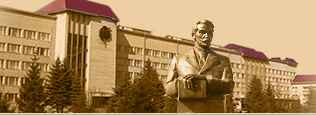TYPIFICATION OF THE NORTHERN REGIONS OF LUGANSK REGION IN TERMS OF RESISTANCE TO THE CHALLENGES OF SOCIO-DEMOGRAPHIC TRANSFORMATIONS
The article is devoted to topical problems of the northern regions of Lugansk region, which are connected with the socio-economic and political situation that has developed in the last 3 years. The consequences of the armed conflict affected every resident of the region. Significantly deteriorated living standards of the population. The regional management system was violated, the resumption of which is aimed at compelling evacuation of state authorities, medical, educational and social institutions and the resumption of their work in new places. The central bodies of state power and the international community rendered a great help to the region in overcoming the crisis phenomena. At present, the management system has been restored, which opens up new perspectives for the implementation of the strategic tasks of development – restoration of Luhansk region, restoration of its industrial and social infrastructure, integration of the region into a single all-Ukrainian economic, informational, political and cultural space. As a result, buffer zone (Kreminsky, Starobilskij, Markovsky and Milovsky districts) and peripheral territories (Troitsky, Swatovsky, Belokurakinsky and Novopiskovsky districts) are formed within the oblast. Some compensation for episodic services of cultural and informational purposes to distant districts of the region is provided by Starobelsk, but its influence on these territories remains insufficient. Socio-demographic indicators have a significant impact on the economy of the region, so we conducted a typification of the northern regions of the Luhansk region in terms of resistance to the challenges of socio-demographic transformations. The region that was the most populous among the regions of our country is currently suffering from the demographic crisis, the destruction of residential areas and infrastructure, which is the reason for the proliferation of a number of problems in various areas and requires attention and prompt effective decisions from public authorities. As a result of the military conflict in the east of Ukraine, a number of social problems arose, and the serious problem is the problem of employment of vulnerable groups that left the zone of the ATO. The complexity of the situation is that internally displaced persons tend to be difficult to adapt to in the new environment and, moreover, to compete on the labor market on an equal footing, and if there are reasons why a person can not leave his home, then the chances to find a job in this case, are minimal. The problem of employment also covers disabled foes who have returned from the ATO zone and can not work under the previous conditions. For this category of people at the moment it is extremely important to get a job because it is a component of psychological and social rehabilitation after tragic events.
Key words: typification, challenges, socio-demographic transformations, sustainability.
References:
- Harasym P.M., Shevchuk I.B. Rol’ i mistse informatsiynykh tekhnolohiy u zabezpechenni rozvytku rehional’noyi ekonomiky // Stalyy rozvytok ekonomiky.– 2014.– #1. – S. 133–135.
- Hrytsunov O.V. Informatsiyni systemy ta tekhnolohiyi: Navch. posibnyk dlya studentiv za napryamom pidhotovky «Transportni tekhnolohiyi». – Kharkiv: KhNAMH, 2015. – 222 s.
- Yermoshenko M.M. Informatsiyno-analitychna pidtrymka analizu diyal’nosti komertsiynykh bankiv // Aktual’ni problemy ekonomiky.– – #10. – S. 59–67.
- Informatsiyni tekhnolohiyi ta modelyuvannya biznes-protsesiv: Navch. posibnyk / O.M. Tomashevs’kyy, H.H. Tsehelyk, M.B. Viter, V.I. Duduk. – K.: Tsentr uchbovoyi literatury, 2015. – 296 s.
- Labsker L.H., Babeshko L.O. Teoryya massovoho obsluzhyvanyya v ekonomycheskoy sfere: Ucheb. posobye. – M.: Banky y byrzhy, 2017. – 319 s.
- Larina R.R., Vladzymyrs’kyy A.V., Baluyeva O.V. Derzhavnyy mekhanizm zabezpechennya informatyzatsiyi systemy okhorony zdorov”ya: Monohrafiya / Pid zah. red. prof. V.V. Dorofiyenko. – Donets’k: Tsyfrovaya typohrafyya, 2014. – 252 s.
- Libanova E. Vplyv zovnishn’oyi mihratsiyi na sotsial’no-ekonomichnyy rozvytok Ukrayiny // Ekonomika Ukrayiny. – 2016. – # 8. – S. 76–80.
- Malynovs’ka O.A. Trudova mihratsiya: sotsial’ni naslidky ta shlyakhy reahuvannya.– K. : NISD, 2014. – 40 s.
- Malynovs’ka O.A. Upravlinnya mihratsiyamy: deyaki vysnovky z yevropeys’koho dosvidu /OA. Malynovs’ka // 3b. nauk. pr. UADU / Za zah. red. V.I. Luhovoho, V.M. Knyazeva. – K.: Vyd-vo UADU, 2015. – # 2. – S. 446–453.
- Malynovs’ka O. Deyaki kontseptual’ni pidkhody do rehulyuvannya trudovoyi mihratsiyi // Trudova mihratsiya naselennya Ukrayiny ta derzhavna prohrama yiyi rehulyuvannya: Materialy mizhnarod. konf., Kyyiv, 18 lyutoho 2005 r. / Rehional’ne predstavnytstvo Fondu im. Fridrikha Eberta v Ukrayini. –K.: Zapovit, 2015. – S. 6–16.
- Khomyn O.Y. Determinanty demohrafichnoyi bezpeky v systemi natsional’noyi bezpeky Ukrayiny // Naukovyy visnyk L’vivs’koho derzhavnoho universytetu vnutrishnikh sprav.– Seriya: Ekonomichna.– 2014.– Vyp. 2. – S. 13–19.
- Shevchuk A.V. Informatsiyni tekhnolohiyi v zabezpechenni sotsial’no-ekonomichnoho rozvytku rehionu: Monohrafiya / Vidp. red. L.K. Semiv. – L., 2017. – 139 s.
